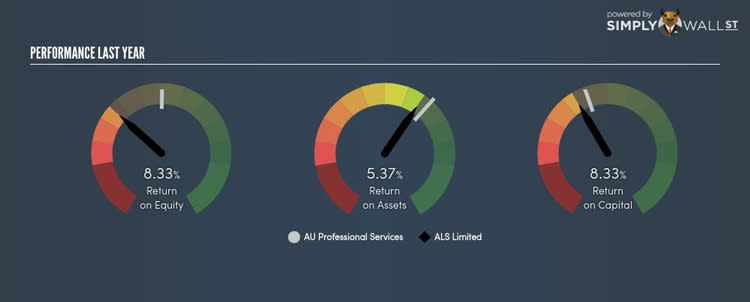What You Must Know About ALS Limited’s (ASX:ALQ) Return on Equity

ALS Limited (ASX:ALQ) delivered a less impressive 8.33% ROE over the past year, compared to the 16.08% return generated by its industry. Though ALQ's recent performance is underwhelming, it is useful to understand what ROE is made up of and how it should be interpreted. Knowing these components can change your views on ALQ's below-average returns. I will take you through how metrics such as financial leverage impact ROE which may affect the overall sustainability of ALQ's returns. Check out our latest analysis for ALS
Breaking down Return on Equity
Firstly, Return on Equity, or ROE, is simply the percentage of last years’ earning against the book value of shareholders’ equity. An ROE of 8.33% implies $0.08 returned on every $1 invested. In most cases, a higher ROE is preferred; however, there are many other factors we must consider prior to making any investment decisions.
Return on Equity = Net Profit ÷ Shareholders Equity
ROE is measured against cost of equity in order to determine the efficiency of ALQ’s equity capital deployed. Its cost of equity is 10.26%. Given a discrepancy of -1.94% between return and cost, this indicated that ALQ may be paying more for its capital than what it’s generating in return. ROE can be dissected into three distinct ratios: net profit margin, asset turnover, and financial leverage. This is called the Dupont Formula:
Dupont Formula
ROE = profit margin × asset turnover × financial leverage
ROE = (annual net profit ÷ sales) × (sales ÷ assets) × (assets ÷ shareholders’ equity)
ROE = annual net profit ÷ shareholders’ equity
Basically, profit margin measures how much of revenue trickles down into earnings which illustrates how efficient ALQ is with its cost management. The other component, asset turnover, illustrates how much revenue ALQ can make from its asset base. Finally, financial leverage will be our main focus today. It shows how much of assets are funded by equity and can show how sustainable ALQ’s capital structure is. Since ROE can be artificially increased through excessive borrowing, we should check ALQ’s historic debt-to-equity ratio. The debt-to-equity ratio currently stands at a sensible 62.56%, meaning the ROE is a result of its capacity to produce profit growth without a huge debt burden.
What this means for you:
Are you a shareholder? ALQ exhibits a weak ROE against its peers, as well as insufficient levels to cover its own cost of equity this year. However, investors shouldn’t despair since ROE is not inflated by excessive debt, which means ALQ still has room to improve shareholder returns by raising debt to fund new investments.
Are you a potential investor? If you are considering investing in ALQ, looking at ROE on its own is not enough to make a well-informed decision. I recommend you do additional fundamental analysis by looking through our most recent infographic report on ALS to help you make a more informed investment decision. If you are not interested in ALQ anymore, you can use our free platform to see our list of stocks with Return on Equity over 20%.
To help readers see pass the short term volatility of the financial market, we aim to bring you a long-term focused research analysis purely driven by fundamental data. Note that our analysis does not factor in the latest price sensitive company announcements.
The author is an independent contributor and at the time of publication had no position in the stocks mentioned.


